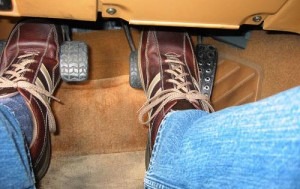Driving a stick shift can be a lot of fun. It offers a level of control that only top-end automatic transmission cars can provide. A manual transmission car also makes you feel involved in the driving since you have to make adjustments with your acceleration and your shift lever on your own.
Manual transmission driving is a skill and it takes constant driving to really learn the intricacies and nuances of driving a stick shift. If you think you’re already good at driving a manual transmission car and but still want to learn some new skills, then you should learn how to do the heel-to-toe shifting technique.
Heel-and-toe shifting is a downshifting technique that is used by professional race car drivers. This is a method that allows the driver to get more power at the turns and more easily accelerate going out of the turn. This is an effective technique that would allow the driver to gain more speed and not lose a lot of momentum.
Here’s how to do a heel-and-toe downshift.
Preparation: heel-and-toe shifting requires the driver to tap on the accelerator and brake pedals simultaneously. To do this, the brake and accelerator pedals should at least be at the same height. Go look at your car and find out if the pedals are the same height.
Heel-and-toe shifting instructions:
- Initiate braking when you’re nearing the corner. Instead of putting your right foot squarely on the brake pedal, tilt your foot slightly to the right – towards the accelerator pedal.
- Press your left foot on the clutch.
- Now, with your right foot still pushing on the brakes, tilt your foot further to the right until you reach the accelerator. Now lightly push the accelerator until you raise the engine’s RPM so it matches your car’s wheel speed. Usually, raising the RPMs between 1,000 to 2,000 more than what the RPM is of the engine so you can downshift by one gear.
- When you’ve reached the desired RPM, shift to third gear.
- Release the clutch.
The challenging part in the heel-and-toe downshifting technique is getting the RPMs just right when you lightly push on the accelerator. It takes a lot of practice to get those RPMs right every single time. Too high an RPM and you’ll let the engine acquire too much speed in relation to the wheel’s RPM so it will be forced to slow down to match the wheel speed when you let go of the clutch. Too low an RPM, on the other hand, the engine will try to increase its RPM – both times your car will jerk. You know you’ve achieved the right RPM because you’ll experience a smooth transition that you’ll want to experience again.
You can practice doing the heel-and-toe technique by practicing on your car with the engine off. Just practice doing the motions again and again until you’ve achieved muscle memory. After this, you can start doing it on the road. Don’t get frustrated if you don’t get it right the first few times. It’s a tricky technique, after all. But with constant practice you can do the heel-and-toe technique effortlessly.
